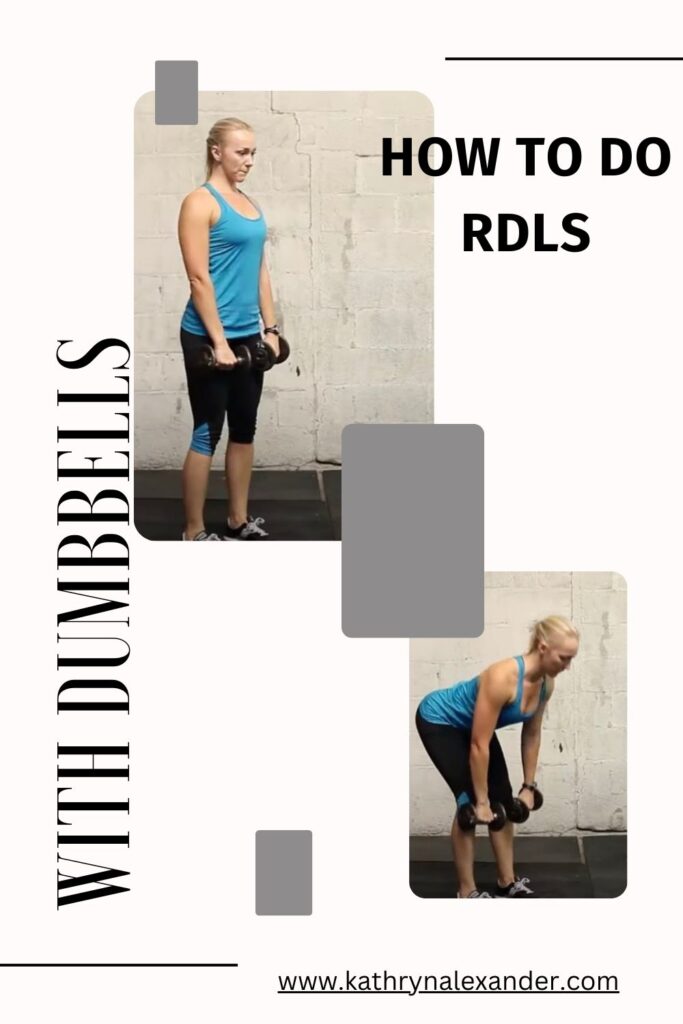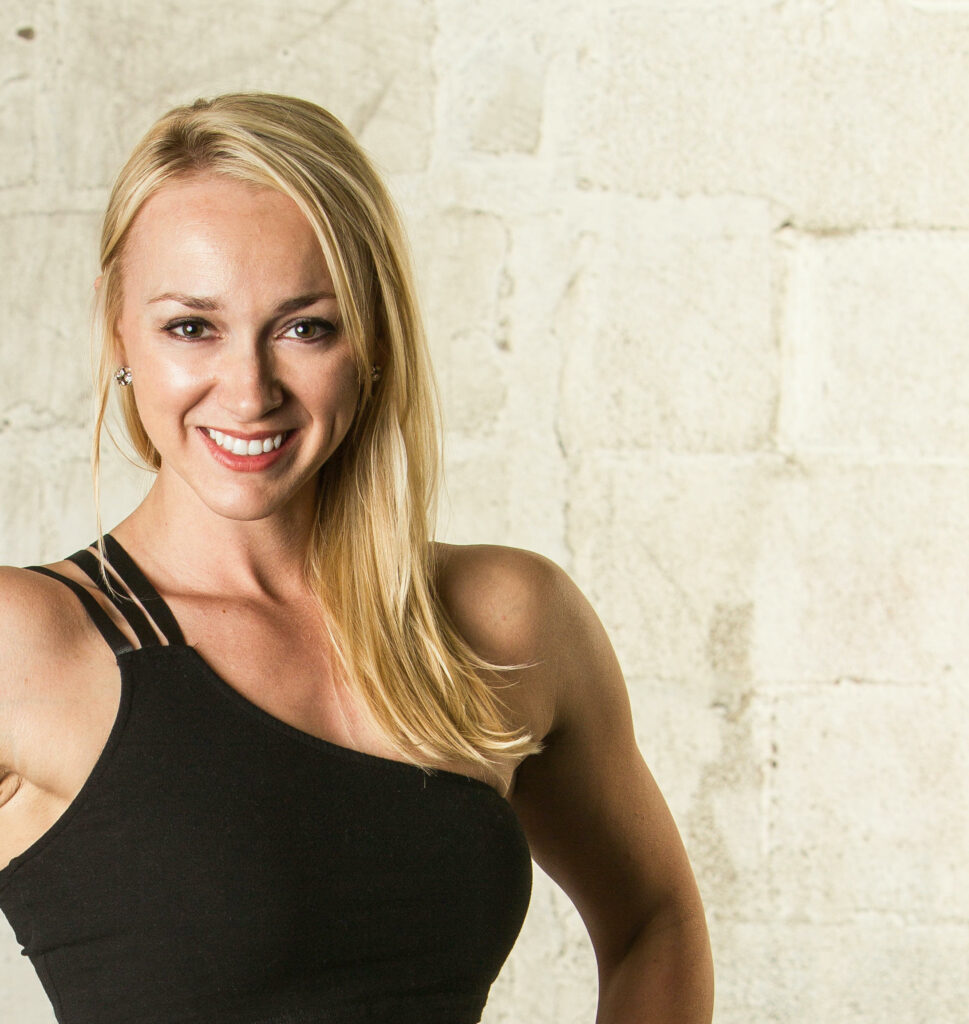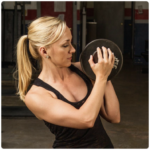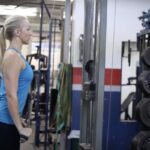Learn how to do RDLs with dumbbells, for hamstring, back and glute development. Romanian deadlifts, also called RDLs, work your entire posterior chain. They are fantastic for many reasons, including being a great strength exercise for your lower body, while being extremely knee friendly. They should have a place in your training routine!
You can do RDLs with a pair of dumbbells, one dumbbell, a barbell, bands, or a kettlebell or two. They are versatile, beneficial, and dare I say, FUN! Actually, many of my clients agree with me, so I’m not just saying it to you because I’m a personal trainer!
RDLs are effective for developing strength, stability, and flexibility in these areas, and are a great way to improve performance in other lifts and athletic activities.
Let’s take a quick look at the benefits of RDLs and what they work, and I’ll explain how to do RDLs with dumbbells for a highly beneficial variation on this great lift.
Benefits of Romanian Deadlifts
As I mentioned before, there are many reasons to do RDLs. They are great for strength, targeted hypertrophy, and well rounded muscular development. Specifically, they improve posterior chain strength in a very functional way. They build strength and endurance of the muscles along the back of your body, which is crucial for overall athletic performance and injury prevention.
A Romanian deadlift is essentially a loaded hip hinge, so practicing RDLs reinforces proper hip hinge mechanics. This is fundamental to athletic movement and strength. The hinge is crucial to the conventional deadlift, squat, kettlebell swings, and generally any movement that utilizes glute and hip function.
The RDL, especially the dumbbell Romanian deadlift, works your entire torso as you maintain a neutral spine through the lift. This stability and strength component is great work for the entirety of your core musculature.
Finally, you can consider Romanian deadlifts like a loaded flexibility exercise. It is essentially a weighted stretch. It is mobility work if you take your time to set up well and move through a big (but appropriate for you) range of motion.
As you can see, Romanian deadlifts are a great exercise which can benefit almost everyone. I highly recommend practicing them in your training program.
What’s The Difference Between Romanian Deadlifts and Traditional Deadlifts?
Romanian deadlifts and traditional deadlifts are both powerful exercises that target the posterior chain, including the hamstrings, glutes, and lower back. However, they have key differences in execution, muscle emphasis, and purpose.
Traditional, or conventional, deadlifts start from the ground with the barbell resting on the floor. You initiate the lift by bending your knees and hips, gripping the bar, and then lifting it by extending your knees and hips until you are standing upright.
Romanian deadlifts start at the top position, from a standing position with the barbell in your hands. The movement begins by hinging at the hips, pushing them back while keeping a slight bend in the knees, lowering the bar along your legs until you feel a stretch in your hamstrings, and then returning to the starting position by driving your hips forward.
This is a big difference, enough that I’d like you to consider these two separate lifts.
With conventional deadlifts, the range of motion is often greater as you lift the bar from the ground to a fully upright position. With Romanian deadlifts, the range of motion is shorter because you only lower the bar to just below your knees or until your hamstrings are fully stretched.
The traditional deadlift is a bit more of a full body exercise. Because there is a greater knee bend, there is a greater involvement of the quads. Both versions of the deadlift work auds, hamstrings, gluteal muscles, lower back/erector spinae, traps, forearms, etc. But, RDLs place a stronger emphasis on the hamstrings and glutes with less involvement of the quads. The lower back and core are still engaged to stabilize the movement.
The conventional barbell deadlift is one of the 3 exercises in powerlifting. It is often called the king of the lifts. Because of this, it is a test of full-body strength. It is a step in powerlifting and strength programs. Typically, you can lift heavier weights since the movement allows for greater power generation. Most people who train can deadlift their body weight, and sometimes even multiples of it.
You’ll hear people ask, “How much do you deadlift?”. The Romanian deadlift, and especially a dumbbell deadlift, is rarely used as a test of strength.
In summary, traditional deadlifts are a full-body strength exercise, while Romanian deadlifts are more specialized for targeting and strengthening the hamstrings and glutes through a controlled hip hinge movement. Both exercises are valuable but serve different purposes in a workout program.
How Do Dumbbell RDL’s Benefit Your Training?
All versions of RDLs (barbell Romanian deadlifts, dumbbell RDLs, single-leg RDL’s, etc) work the following muscle groups. Where dumbbell Romanian deadlifts differ is that they require you to contribute more of the stability, since you are using two different implements instead of one. In other words, holding a barbell is much more stable than holding two dumbbells. This means that the dumbbell work is essentially tougher because you have to stabilize both pieces of equipment.
For example, if you do a barbell Romanian deadlift with 100 pounds, then you do a dumbbell RDL with two 50 pound dumbbells, you’ll notice that the dumbbell version is much tougher even though it weights the same in total. It’ll feel harder to hold, more challenging on your grip, and possibly less controlled throughout the movement. This is FINE and there are benefits to performing their either way! It’s just important to know that even though they are very similar, they are not the same lift.
Also, it’s great to practice both. You might be in a facility that only has dumbbells, or in a hotel gym that doesn’t have barbells. In this case, practice and learn how to do RDLs with dumbbells, and practice a variety of deadlift variations to optimize your strength development.
What Muscles Do RDLs Work?
In short, Romanian deadlifts work several groups of muscles, and primarily work the posterior chain muscles. These primary muscle groups work in both the dumbbell and barbell RDL lifts:
- Hamstrings: The main muscle group worked during RDLs. Hamstrings are comprised of the biceps femoris, semimembranosus, and semitendinosus.
- Glutes: They are engaged to a significant degree, especially during the hip extension phase. The gluteal muscles include the gluteus maximus, the gluteus medius, and gluteus minimus.
- Lower Back (Erector Spinae): Helps to maintain a neutral spine throughout the movement.
- Adductors: This group of muscles in the inner thigh muscles assist in stabilizing the legs.
- Core Muscles: Engaged to stabilize the torso during the lift. Strong core muscles are crucial to protecting your lumbar spine.
Deadlifts, RDLs, and stiff leg deadlifts primary work your lower body, but they work your upper body as well. Your upper body, especially your back muscles, perform a crucial stability role during RDLs.
How to Perform Romanian Deadlifts with Dumbbells
- Setup: Stand with feet hip-width apart, holding a barbell or dumbbells in front of your thighs with an closed (thumbs wrapped) overhand grip. Keep your knees slightly bent. You can experiment with foot positioning, but I like to stand with my feet about shoulder width.
- Movement:
- stand tall with dumbbells in front of you
- hold the dumbbells close to your body, even touching the front of your legs, for the duration of the exercise
- squeeze your back to keep it straight and neutral
- shoulder blades don’t have to be aggressively pressed back – but keep your upper back strong and neutral
- push your hips behind you with knees soft
- let your hamstrings stretch as you lower the weights, keeping them close to your legs
- at the bottom of the movement, drive your big toes into the ground and push your hips forward (squeeze glutes) until you are standing tall again
- Return: Engage your glutes and hamstrings to return to the starting position, maintaining the barbell close to your body throughout the lift.
Tips for Proper Form During the Dumbbell RDL
- Neutral Spine: Maintain a neutral position in your back throughout the movement to prevent injury. You can think of keeping a flat back. No big arch or tuck in your low back.
- Controlled Movement: Focus on a controlled movement, particularly during the lowering phase, to maximize muscle engagement and reduce the risk of injury. It doesn’t have to be excessively slow, but don’t let gravity steal your work. No dive bombing!
- Weight Selection: Start with a light weight to master the form before progressing to heavier loads.
- Foot Position: Ensure your feet are firmly planted and your weight is distributed evenly across your heels and midfoot. Press into the ground with your big toe as you initiate movement and return to your tall standing position.
Variations of Romanian Deadlifts
There are many Romanian deadlift variations, and they are all uniquely beneficial.
Single-Leg Romanian Deadlift
Performed on one leg, the single leg RDL increases the balance and stability challenges. Theoretically, these are great for working muscle imbalances and addressing lower body strength. In practice, they’re just sometimes too difficult. If your goal is to work the posterior during your RDL, but your balance isn’t letting you, then you can try the B Stance, or kickstand, RDL
How to do the single leg Romanian deadlift
- -stand tall with dumbbells in front of you
- -shift your weight to one leg, while the other leg hovers
- -(the other leg will move with your torso through the movement)
- -hold the dumbbells close to your body for the duration of the exercise
- -squeeze your back to keep it straight and neutral
- -shoulder blades don’t have to be aggressively pressed back – but keep your upper back strong and neutral
- -push your hips behind you with knees soft
- let your hamstrings stretch as you lower the weights, keeping them close to your legs
- -at the bottom of the movement, drive your big toes into the ground and push your hips forward (squeeze glutes) until you are standing tall again
B Stance RDL
The B stance RDL is a staggered stance lift. It allows you to shift most of your weight, and most of the challenge to one leg. By having both feet on the ground, though, then you remove the challenge balance presents. In this case, this is good. If you aren’t using this as a balance exercise, then you don’t want balance to limit it.
In this video, I demonstrate how to do a B stance RDL with a kettlebell. It’s similar if you use a dumbbell.
- stand tall with dumbbells in front of you
- shift most of your weight to one leg
- keeping your hips square, step the other leg slightly behind you
- hold the dumbbells close to your body for the duration of the exercise
- squeeze your back to keep it straight and neutral
- shoulder blades don’t have to be aggressively pressed back – but keep your upper back strong and neutral
- push your hips behind you with knees soft
- let your hamstrings stretch as you lower the weights, keeping them close to your legs
- at the bottom of the movement, drive your big toes into the ground and push your hips forward (squeeze glutes) until you are standing tall again
- return to your start position at the top of the movement and repeat for your goal number of reps
Stiff Leg Deadlifts
Stiff leg deadlifts, or straight leg deadlifts, are deadlifts performed with completely straight legs or even locked out knees. As you can imagine, these are a hard hinge that require a strong back and glutes too. Truth be told, I really don’t practice these or have my clients do them, so I’m not going to cover them here. There is nothing wrong with them, but I think RDLs are more beneficial to most of my client’s daily activities and athletic endeavors.
Need other minimal equipment ideas? Here’s a home leg workout with dumbbells. Or Try this full body band workout at home.
Common Mistakes to Avoid While Doing the RDL
The most common mistake people make while doing Romanian desdlifts is not effectively utilizing the hip hinge movement pattern. There is a true need for dialing in the mind-muscle connection to utilize the hinge well. When that’s not fully understood, the lifter will tend to round their lower back and not let the hips move with the lift.
There is not a single cue that can make this make sense for every lifter, but it can help to think about “clamping down” a straight back, and letting the hamstrings (back of your leg) open up. This way the hips can move through the lift, and the lifter can effectively utilize the glutes to power the hinge. This can really help you learn how to do RDLs with dumbbells.
Need some upper body work? Here’s a dumbbell shoulder workout you can do at home.

Learn How to Do RDLs with Dumbbells
Incorporating Romanian deadlifts and their different variations into your workout routine can significantly enhance your strength, flexibility, and performance, particularly for activities involving the lower body and posterior chain. They will translate into stronger squats, deadlifts, good mornings and other RDL variations. They will increase hip strength, low back strength, and glute strength.
Deadlifts, dumbbell deadlifts, and their variations are some of the best exercises you can practice. You will see a difference in the ease of your daily tasks, on hikes around town (here are my favorite hikes in Austin) and in maintaining good posture. Having a strong posterior chain always feels good too.
Work With Me!
If you are looking for a personal trainer in Austin, I’d love to talk with you! If you are not in Austin, Round Rock, or central Texas, let’s talk about online training.
Message me here for a free consult about personal training in Austin, Texas, or here for online personal training, and we’ll discuss your goals, background, equipment availability, schedule, and exercise preferences.
Let’s get you strong and healthy! 

About the author
Kathryn Alexander is a strength coach and personal trainer in Austin, Texas. She loves hiking, college football, and the feel of a perfectly knurled barbell. Read more about Kathryn here.







